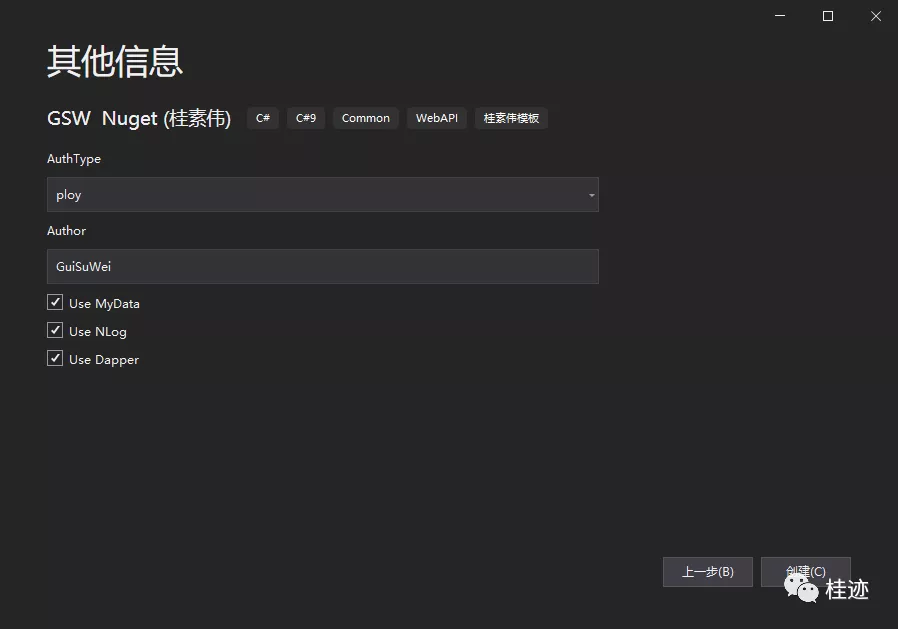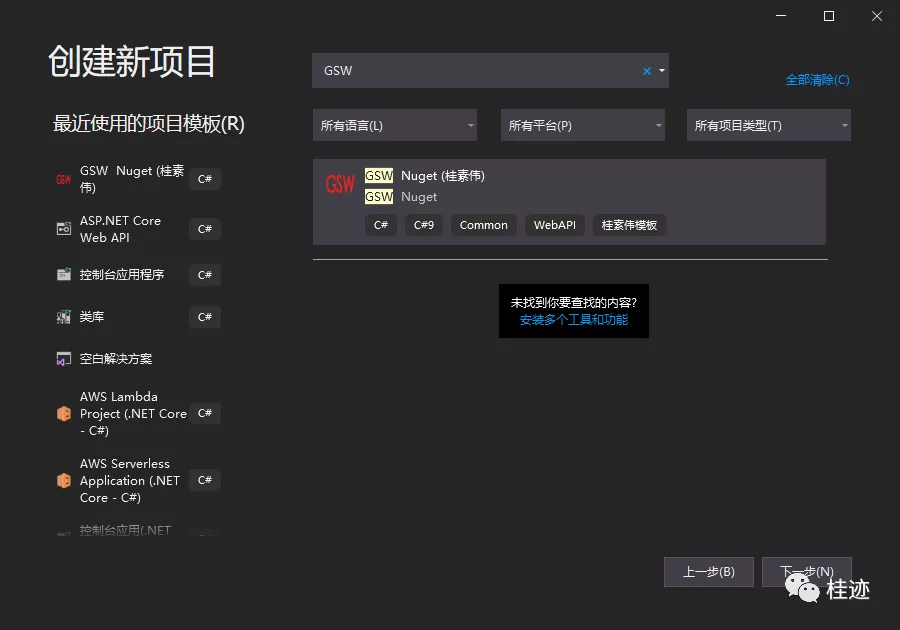.Net项目模板进阶

友情提示:这篇有点长,有点绕,加油!
上一篇文章,简单的说明了一下.net项目模板的创建,主要是通过在项目文件*.csproj同目录下添加.template.config文件夹和里面的template.json,再用dotnet new -i来安装项目模板的,本篇继续深入。
首先定个小目标:
实现一个web api项目模板,可以选择引入NLog库,选择引入Dapper库;同时希望可以选择用户权限认证方式,这里假设是三种:无,固定角色,自定义策略;还可以在创建项目时,输入文本信息(比如作者信息),上面这些输入项,都是通过模板参数来实现的。
其实仔细分析一下,是三类参数:1、判断类,就是用不用这个三方库;2、选择类,三种授权方式中选一种;3、输入文本类。
同时在上一篇文章中,我们是直接用源码生成模板的,问题来了,不可能让大家都用源码来生成本地模板,这里如果能打成个包,大家使用,就简单多了,确实微信把模板项目生成一个nupkg包,可以上传到nuget.org上,供其他人使用。
那接来看实现步骤吧。
为了大家有直观的感受,我先把创建项目时,需要用户录入的参数展示出来:

这次先看模板文件
1、template.json,在项目文件夹下的.template.config目录下
{
"$schema": "http://json.schemastore.org/template",
"author": "桂素伟",
"classifications": [ "Common", "桂素伟模板", "WebAPI", "C#9" ],
"identity": "GSW Nuget",
"name": "GSW Nuget",
"shortName": "GSWNuget",
"tags": {
"language": "C#",
"type": "project"
},
"sourceName": "GSWNuget",
"symbols": {
"Author": {
"type": "parameter",
"datatype": "text",
"defaultValue": "",
"replaces": "author",
"description": "作者"
},
"UseNLog": {
"type": "parameter",
"datatype": "bool",
"defaultValue": "true",
"description": "是否使用NLog"
},
"UseDapper": {
"type": "parameter",
"datatype": "bool",
"defaultValue": "true",
"description": "是否使用Dapper"
},
"AuthType": {
"type": "parameter",
"datatype": "choice",
"defaultValue": "None",
"choices": [
{
"choice": "None",
"description": "None"
},
{
"choice": "Role",
"description": "Role"
},
{
"choice": "policy",
"description": "Policy"
}
]
},
"None": {
"type": "computed",
"value": "(AuthType == \"None\")"
},
"Role": {
"type": "computed",
"value": "(AuthType == \"Role\")"
},
"Policy": {
"type": "computed",
"value": "(AuthType == \"Policy\")"
}
},
"sources": [
{
"modifiers": [
{
"condition": "(!UseNLog)",
"exclude": [ "NLog.config" ]
}
]
}
]
}
"sourceName": "GSWNuget",是项目名称。
"symbols"下是配置模板参数:
UseDapper,UseNLog是bool类型 ,让创建项目的人员来选择是否引入这些三方包。
Author是输入文本类型,其中的replate是要把项目文件中的所有author换成用户输入项目,所以这个名称最好命名的不要那么通用。
AuthType是选择权限的验证规划,这里还在下面增加了三个选择项的运算结果项,bool类型 :None,Role,Policy,是通过用户的选择来决定具体的值。
UseNLog,虽然是个bool类型,但是他的用途特殊,在了json文件的后面,有个sources,这个的作用是决定NLog.config文件,显示不显示在用户的项目中,决定文件的存留与否。
2、ide.host.json,为了在IDE中显示这些值,供用户输入,还需要在template.json同目录下创建一个ide.host.json文件,这个文件的作用就是在ide中把用户录入项友好的提示给用户,同时准备了一个icon.png,来给这个项目模板来充当图标,它的存放位置与ide.host.json在同一级。
{
"$schema": "http://json.schemastore.org/vs-2017.3.host",
"icon": "icon.png",
"symbolInfo": [
{
"id": "UseNLog",
"name": {
"text": "Use NLog"
},
"isVisible": "true"
},
{
"id": "Author",
"name": {
"text": "Author"
},
"isVisible": "true"
},
{
"id": "UseDapper",
"name": {
"text": "Use Dapper"
},
"isVisible": "true"
},
{
"id": "AuthType",
"isVisible": "true"
}
]
}
3、创建web api项目GSWNuget,围绕着上面三个需求展开,先看program.cs文件:
/********************************
*作者:author
********************************/
using Microsoft.AspNetCore.Hosting;
using Microsoft.Extensions.Configuration;
using Microsoft.Extensions.Hosting;
using Microsoft.Extensions.Logging;
using System;
using System.Collections.Generic;
using System.Linq;
using System.Threading.Tasks;
#if (UseNLog)
using NLog.Web;
#endif
namespace GSWNuget
{
public class Program
{
#if (UseNLog)
public static void Main(string[] args)
{
var logger = NLogBuilder.ConfigureNLog("nlog.config").GetCurrentClassLogger();
try
{
logger.Debug("init main");
CreateHostBuilder(args).Build().Run();
}
catch (Exception exception)
{
logger.Error(exception, "Stopped program because of exception");
throw;
}
finally
{
NLog.LogManager.Shutdown();
}
}
public static IHostBuilder CreateHostBuilder(string[] args) =>
Host.CreateDefaultBuilder(args)
.ConfigureWebHostDefaults(webBuilder =>
{
webBuilder.UseStartup<Startup>();
})
.ConfigureLogging(logging =>
{
// logging.ClearProviders();
// logging.SetMinimumLevel(LogLevel.Trace);
})
.UseNLog();
#else
public static void Main(string[] args)
{
CreateHostBuilder(args).Build().Run();
}
public static IHostBuilder CreateHostBuilder(string[] args) =>
Host.CreateDefaultBuilder(args)
.ConfigureWebHostDefaults(webBuilder =>
{
webBuilder.UseStartup<Startup>();
});
#endif
}
}
#if #endif 是判断用户的输入,决定用户项目走的分支,这里是NLog的引入与不引入的分类,其实不有一个点,NLog的库要不要restore,这个在项目文件中再说。
再有一个是author,最终会被展示图的GuiSuWei那个文本替换。
再看一下GSWNuget.csproj,同样是#if,但需要在<!-- -->中,毕竟是xml。
<Project Sdk="Microsoft.NET.Sdk.Web">
<PropertyGroup>
<TargetFramework>net5.0</TargetFramework>
<Version>2.0.0</Version>
</PropertyGroup>
<ItemGroup>
<!--#if (UseDapper)
<PackageReference Include="Dapper" Version="2.0.78" />
#endif-->
<PackageReference Include="Swashbuckle.AspNetCore" Version="5.6.3" />
<PackageReference Include="NLog.Web.AspNetCore" Version="4.12.0" />
</ItemGroup>
</Project>
再看一下starup.cs
/********************************
*作者:author
********************************/
using Microsoft.AspNetCore.Builder;
using Microsoft.AspNetCore.Hosting;
using Microsoft.AspNetCore.HttpsPolicy;
using Microsoft.AspNetCore.Mvc;
using Microsoft.Extensions.Configuration;
using Microsoft.Extensions.DependencyInjection;
using Microsoft.Extensions.Hosting;
using Microsoft.Extensions.Logging;
using Microsoft.OpenApi.Models;
using System;
using System.Collections.Generic;
using System.Linq;
using System.Threading.Tasks;
namespace GSWNuget
{
public class Startup
{
public Startup(IConfiguration configuration)
{
Configuration = configuration;
}
public IConfiguration Configuration { get; }
public void ConfigureServices(IServiceCollection services)
{
#if None
var authType = "None";
#endif
#if Role
var authType = "Role";
#endif
#if Ploy
var authType = "Ploy";
#endif
services.AddControllers();
services.AddSwaggerGen(c =>
{
c.SwaggerDoc("v1", new OpenApiInfo { Title = "GSWNuget", Version = "v1" });
});
}
public void Configure(IApplicationBuilder app, IWebHostEnvironment env)
{
if (env.IsDevelopment())
{
app.UseDeveloperExceptionPage();
app.UseSwagger();
app.UseSwaggerUI(c => c.SwaggerEndpoint("/swagger/v1/swagger.json", "GSWNuget v1"));
}
app.UseHttpsRedirection();
app.UseRouting();
app.UseAuthorization();
app.UseEndpoints(endpoints =>
{
endpoints.MapControllers();
});
}
}
}
其中的 #if None ,#if Role,#if Policy是选择后结果的分支对应。
再看一下appsettings.json,在appsettings中是在//后用#if
{
////#if(UseDapper)
//"Dapper": "dapper config",
////#endif
////#if(UseNLog)
//"LogConfig": "log config",
////#endif
"Logging": {
"LogLevel": {
"Default": "Information",
"Microsoft": "Warning",
"Microsoft.Hosting.Lifetime": "Warning"
}
},
"AllowedHosts": "*"
}
到这里,项目基本准备完毕,接下来就要打包成nupkg,这里要用到nuget.exe(这里下载 https://www.nuget.org/downloads),通过命令把模板项目GSWNuget生成nupkg,nuget.exe生成nupkg时需要一个配置文件,GSWNuget.nuspec,这个文件与GSWNuget项目目录在同一级别。
<?xml version="1.0" encoding="utf-8"?>
<package xmlns="http://schemas.microsoft.com/packaging/2012/06/nuspec.xsd">
<metadata>
<id>GSWNuget</id>
<version>0.0.1</version>
<description>
这是我用来生成Nuget格式的Templage。
</description>
<authors>桂素伟</authors>
<license type="expression">MIT</license>
<packageTypes>
<packageType name="Template" />
</packageTypes>
</metadata>
<files>
<file src="GSWNuget\**\*.*" exclude="GSWNuget\**\bin\**\*.*;GSWNuget\**\obj\**\*.*" target="Content" />
</files>
</package>
接下来执行命令:
> .\nuget.exe pack .\GSWNuget.nuspec -OutputDirectory .\nupkg
会在nupkg下生成GSWNuget.1.0.0.nupkg文件
安装GSWNuget项目模板:
> dotnet new -i GSWNuget.1.0.0.nupkg
这里,在我们的项目模板中会增加一个GSWNuget类型的项目模板。
接下来是享受成果的时候了,打开vs,新建项目,搜索GSW,就可以新建自己模板的项目了。

这里可以测试一下不同的选择,生成的是不是想要的结果
找时间做一个自己真正项目模板,再分享给大家。






【推荐】国内首个AI IDE,深度理解中文开发场景,立即下载体验Trae
【推荐】编程新体验,更懂你的AI,立即体验豆包MarsCode编程助手
【推荐】抖音旗下AI助手豆包,你的智能百科全书,全免费不限次数
【推荐】轻量又高性能的 SSH 工具 IShell:AI 加持,快人一步
· DeepSeek 开源周回顾「GitHub 热点速览」
· 物流快递公司核心技术能力-地址解析分单基础技术分享
· .NET 10首个预览版发布:重大改进与新特性概览!
· AI与.NET技术实操系列(二):开始使用ML.NET
· 单线程的Redis速度为什么快?